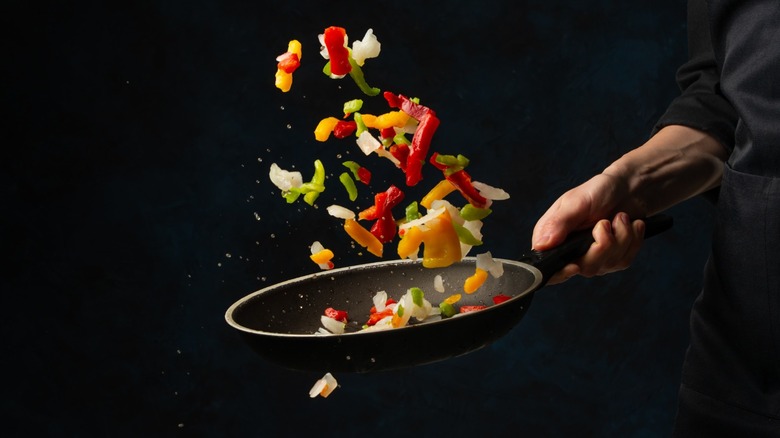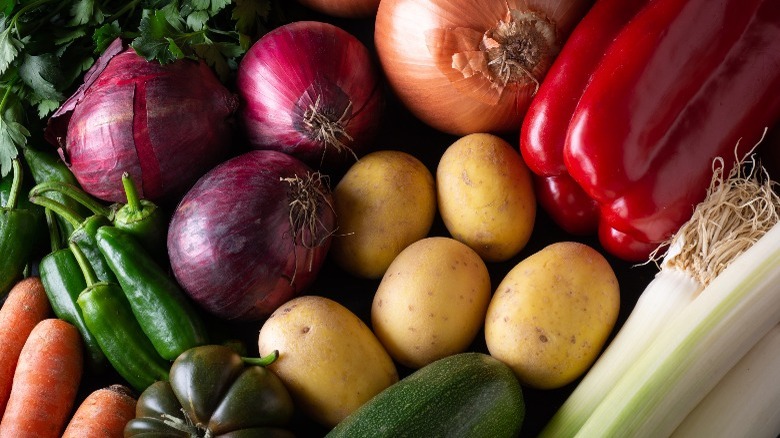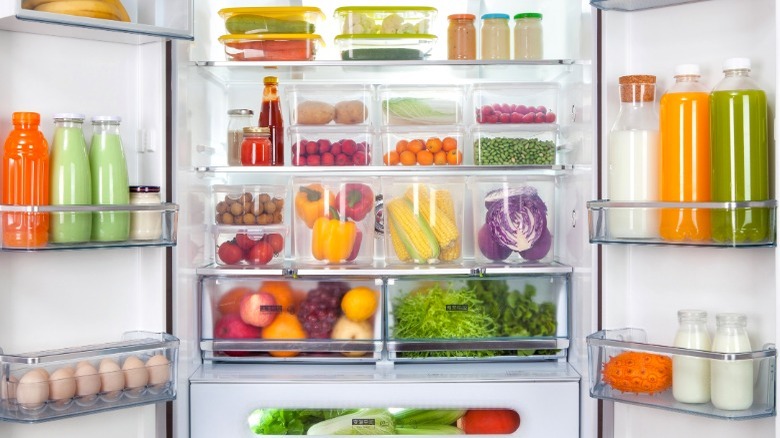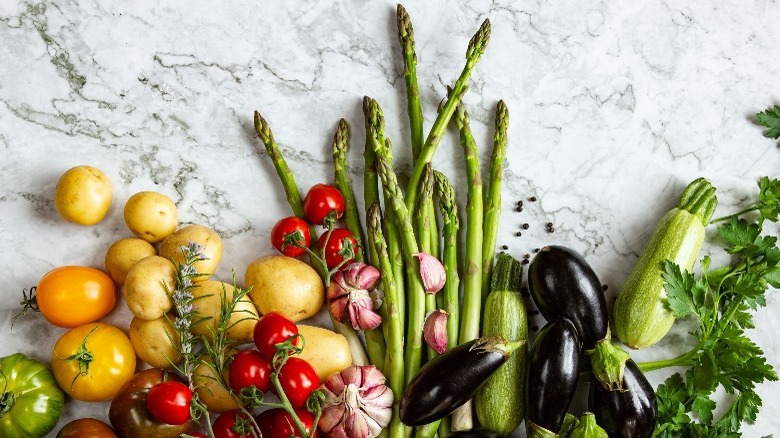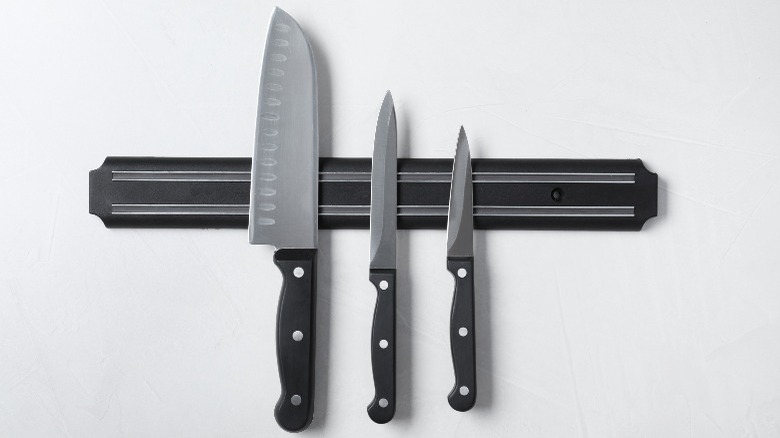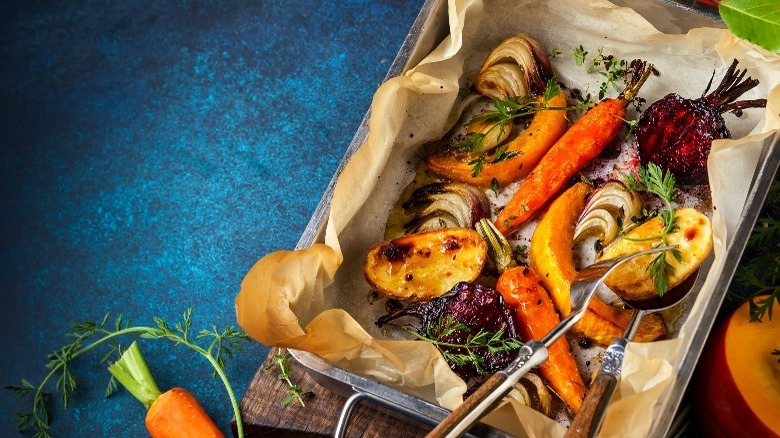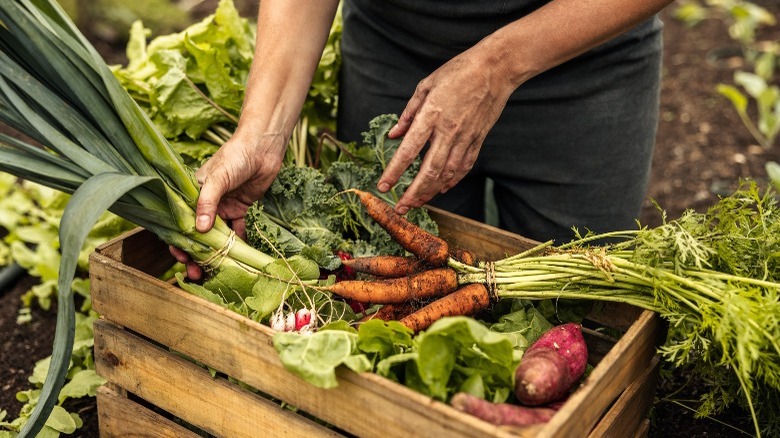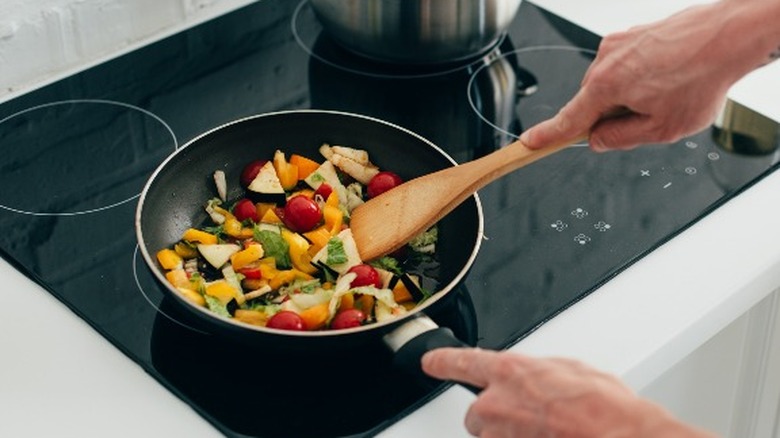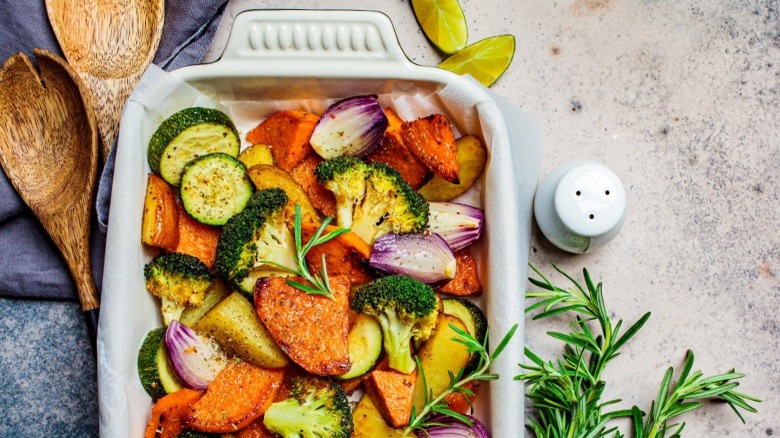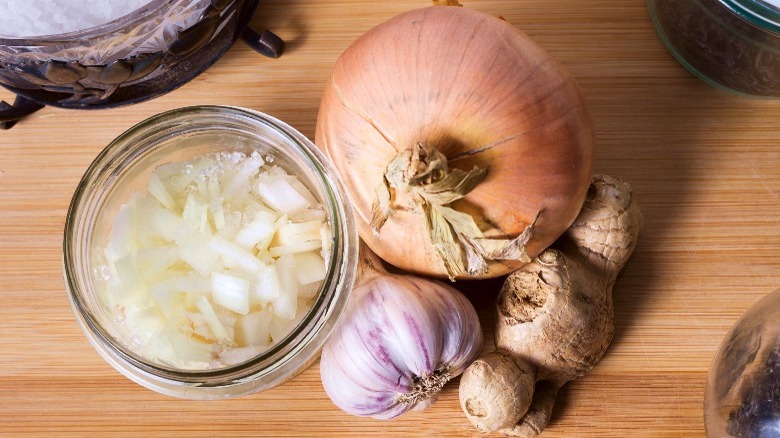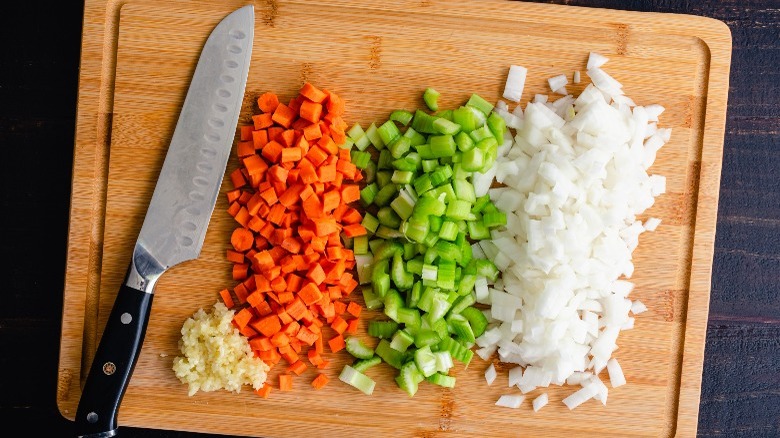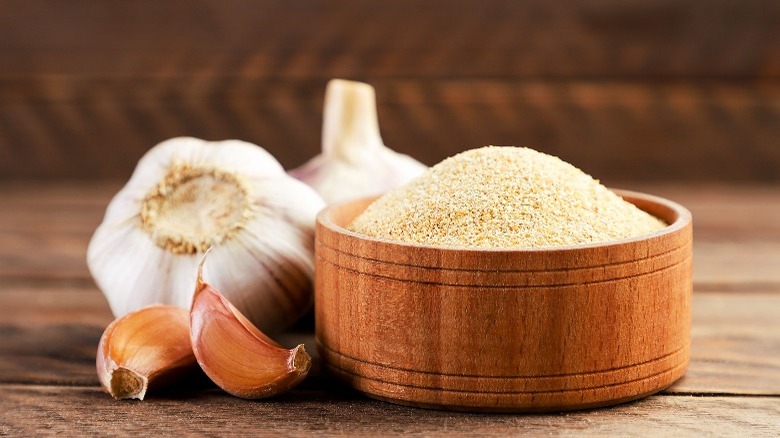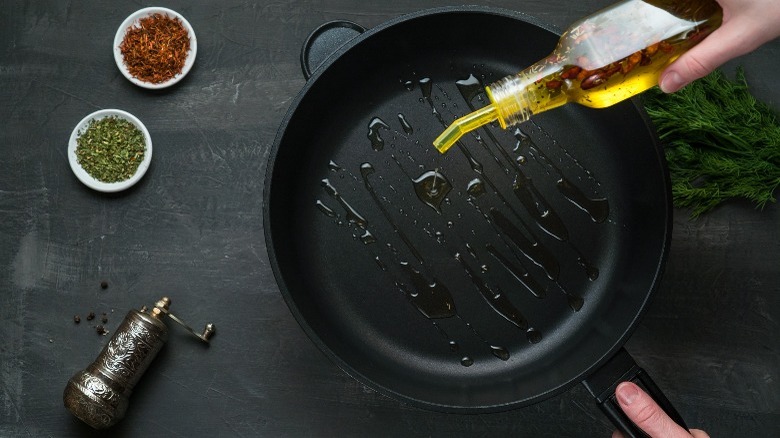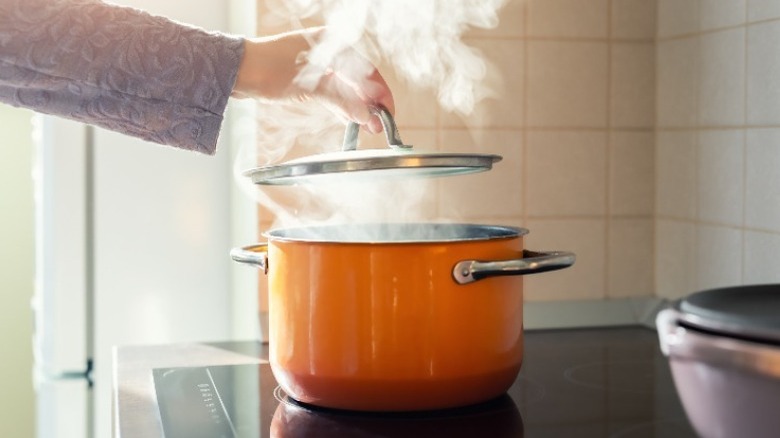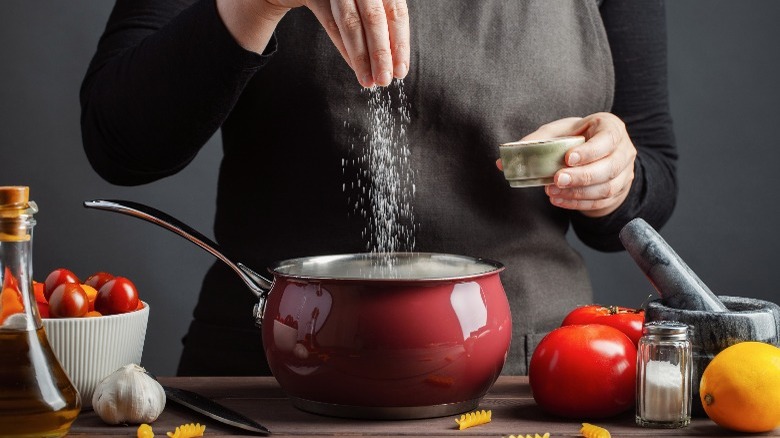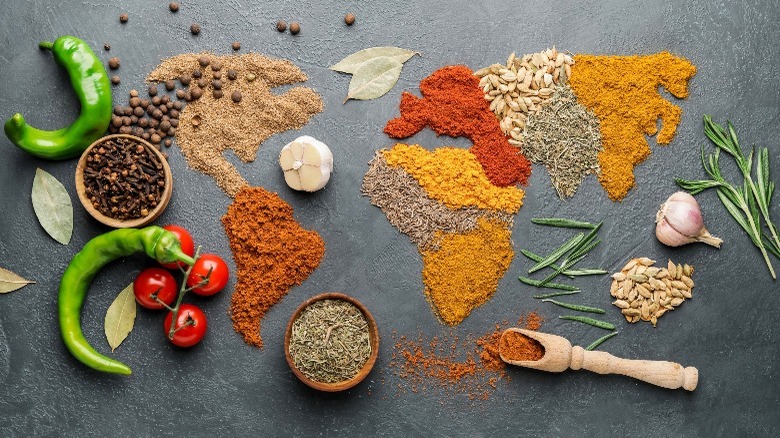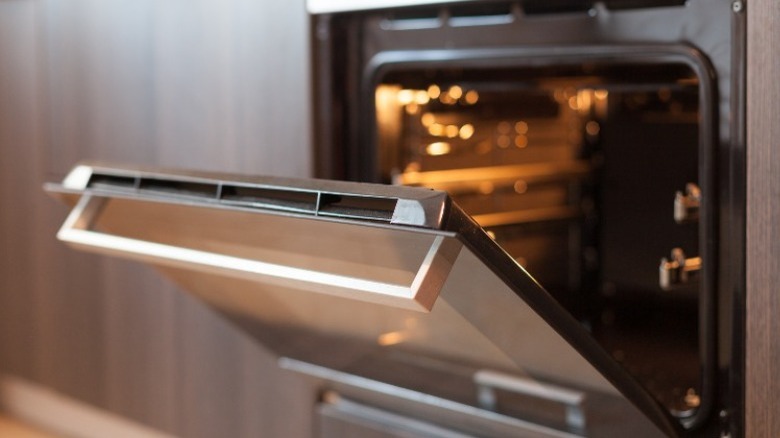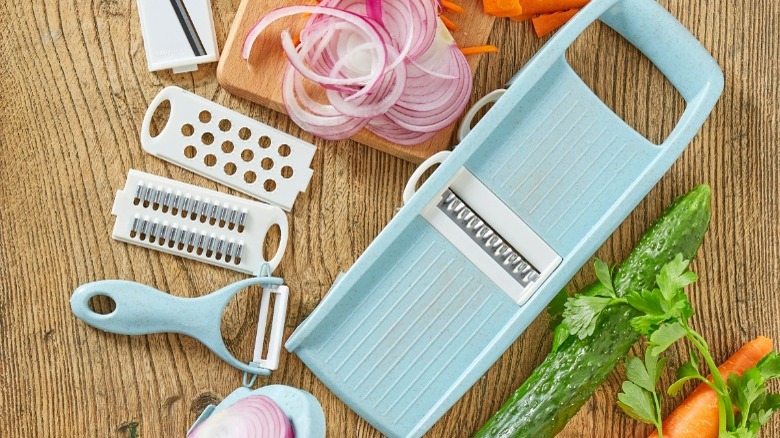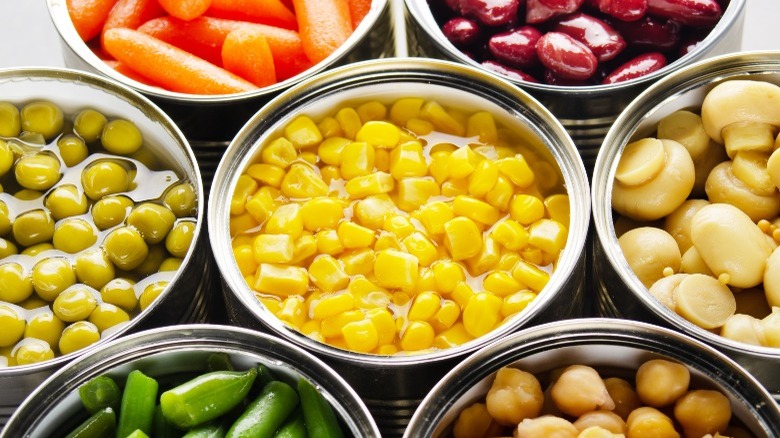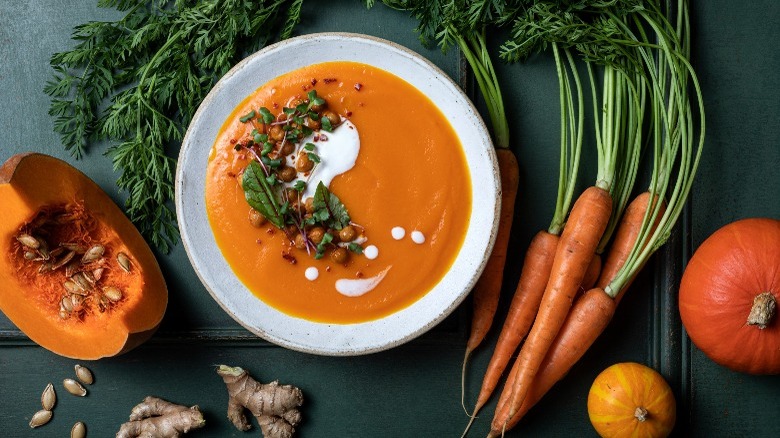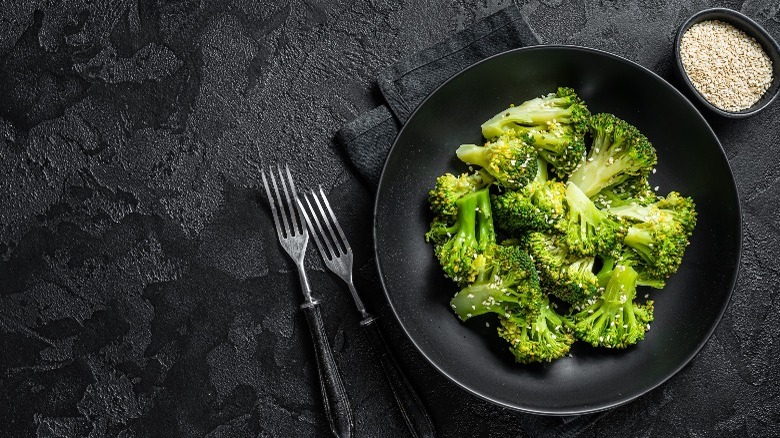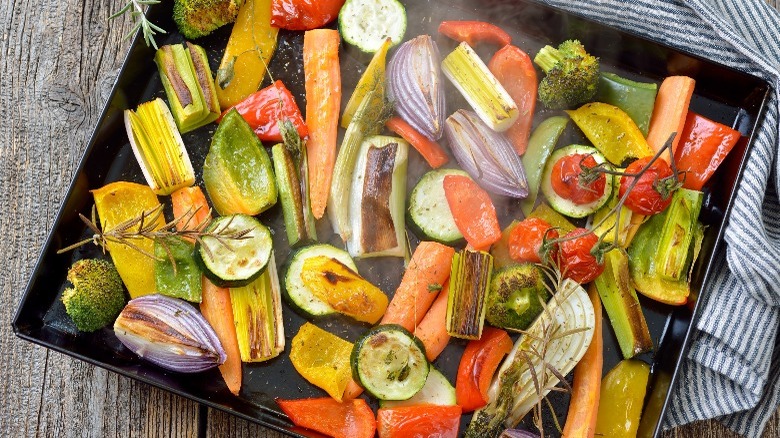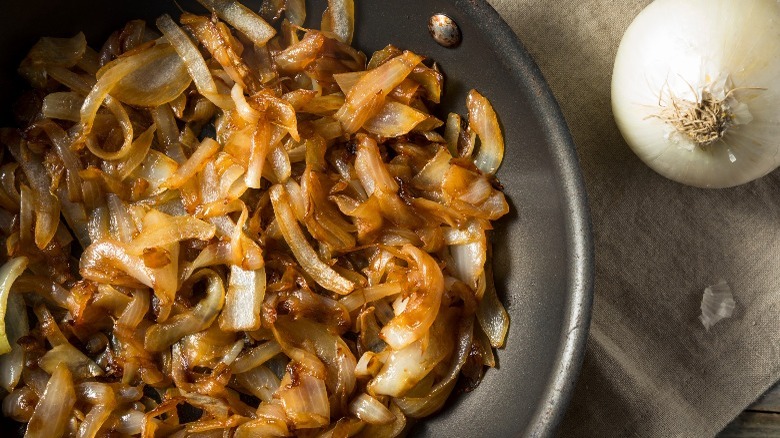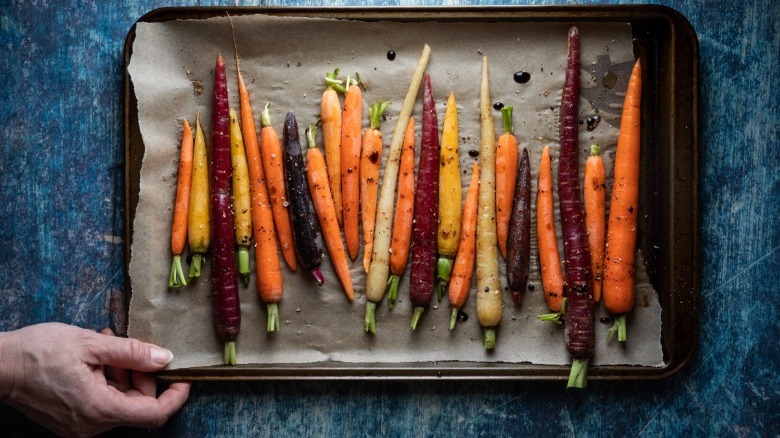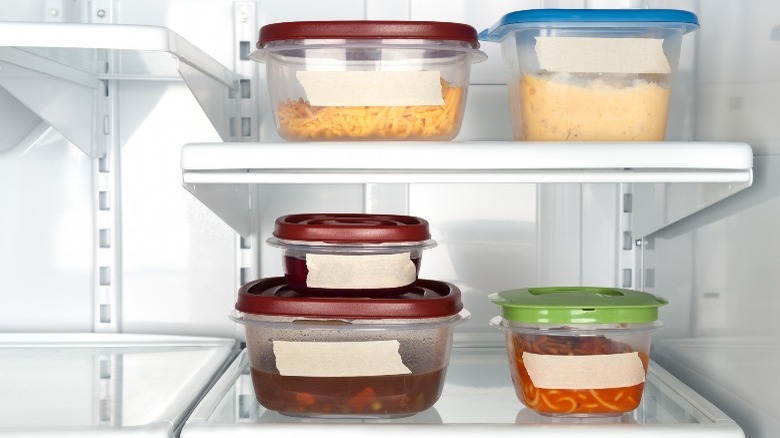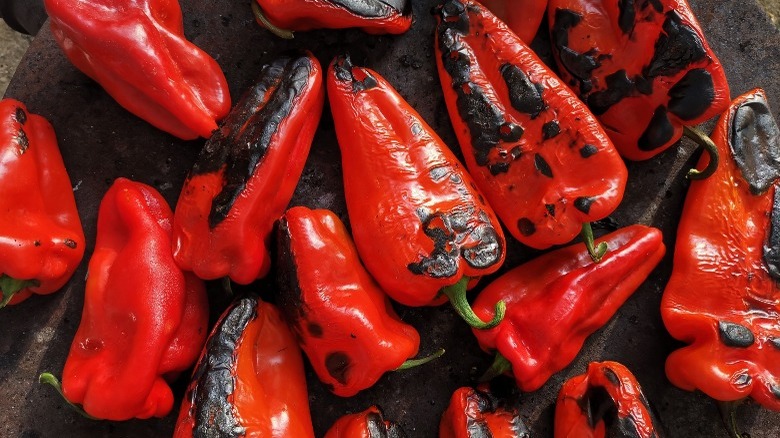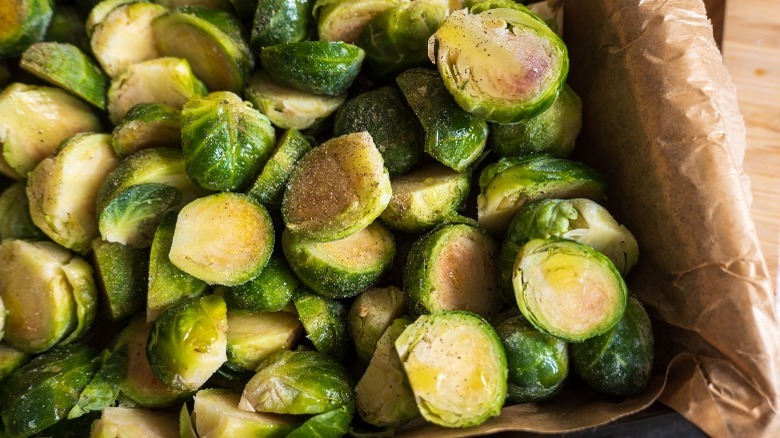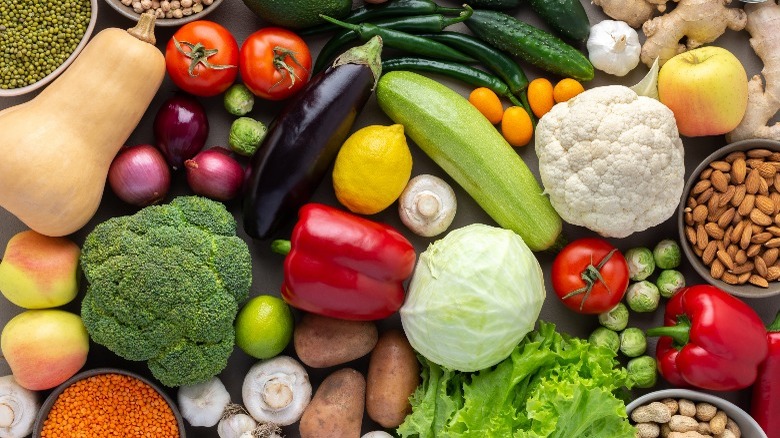27 Tips You Need When Cooking With Vegetables
If we had a dollar every time someone told us to eat our vegetables, we'd all be able to afford private chefs who would free us from having to learn how to cook them well ourselves. But alas, most of us have to tackle this task on our own. Cooking with vegetables at home can certainly be daunting, with so many different textures, flavors, and techniques to consider. So whether you're a novice or a veteran plant-based eater, you can always benefit from a few tips to get the most out of your veggie-centric meals.
We've compiled some tips you need when cooking with vegetables — from understanding the importance of staples and how to store them to the basic techniques of cooking and seasoning, and finally, to some creative ideas for substituting, mixing, and roasting vegetables. Whether you're looking for ways to add flavor or make your meals healthier, these tips will help you create vibrant, nutritious plant-forward dishes. So don't be intimidated; get creative, and explore the world of vegetable cooking.
Figure out your staples
Being consistently able to throw together delicious veggie-packed meals is impossible without a well-stocked kitchen. If you're eating plant-based or hoping to reduce your meat consumption, you need to identify which plant foods you'll rely on regularly. Consider different frozen produce and low-cost vegetables with a long shelf life, such as potatoes, butternut squash, cabbage, carrots, beets, and other root vegetables. Additionally, it might be wise to keep onions on hand since they are among the best vegetable for home cooking.
Optimize storage
As delicious as fresh produce is, it's also highly perishable. To get the most out of your vegetables while cutting down on food waste, you need to avoid common storage mistakes. To do so, learn which vegetables are sensitive to temperature, humidity, and ethylene gas, and don't cramp them all up in your crisper drawer. Additionally, don't wash or cut your vegetables unless you intend to eat them soon to avoid spoilage. Finally, make sure to eat the oldest produce first and try to use up wilted or overripe vegetables instead of throwing them out.
Embrace seasonality
The year-round abundance of produce is an undeniable perk of the modern global food system. However, there are drawbacks. First, eating out-of-season vegetables harvested before they were ripe means getting less nutritional value. Plus, many big vegetable suppliers prioritize uniformity and long shelf life over flavor. As a result, the tomatoes and cucumbers you buy in the midst of winter may taste subpar and have minimum health benefits. Therefore, it is best to choose seasonal produce whenever possible.
Pick the right knife and sharpen it
Having a good set of knives and utilizing them correctly can make veggie prep quicker and more enjoyable. As a rule of thumb, use a paring knife for precision cuts and an all-purpose chef knife for the rest. Once you pick the right knife, don't make the dangerous mistake of letting it dull. While it might seem counterintuitive, a sharp knife is safer to use, as it slices through produce more effortlessly, minimizing cutting risk. To test the sharpness of your knife, cut a tomato or an onion and look for signs of resistance and skin pull.
Keep the skin on
If you use your vegetable peeler religiously, consider giving it a day off. Lots of vegetables actually don't need to be peeled; if the skin is edible, then a thorough scrub is all the prep you need. That means you can skip peeling carrots, cucumbers, eggplants, potatoes, squash, and zucchini, among others. Using the oven will make peeling beets easy: roast well-scrubbed bulbs at 350 F, and you're good to go. Not peeling the vegetables will give them a rustic look while maximizing nutritional intake, as they are one of the most nutrient-rich parts of the plant.
Apply the root-to-stalk principle
The concept of root-to-stalk cooking celebrates components of vegetables that are usually discarded, like stalks, tops, ribs, and stems. By using whole vegetables instead of the most commonly eaten parts, you can lower food waste and tap into your culinary ingenuity. Among the foods you need to stop throwing out and start cooking with are herb and vegetable stems, peels and scraps, spent corn cobs, and root vegetable tops. All could be used to make sauces, stocks, pickles, and drinks; some can even be regrown!
Master the three main stovetop techniques
You don't have to be a competent chef to transform raw vegetables into an appetizing part of your dinner. However, to get your vegetables to that perfectly tender-crisp stage, you'll need to familiarize yourself with the main stovetop cooking methods: blanching, steaming, and sautéing.
Blanching involves boiling vegetables briefly in a large pot of water before immersing them in ice water to terminate the cooking process, which helps them retain their color. Steaming requires a small amount of evaporating water. Finally, sautéing is code for cooking small batches of vegetables in oil, resulting in a crisp texture and lightly charred surface.
Give veggies space
Overcrowding the pan is one of the most common mistakes home cooks make with vegetables. You want them to cook quicker, so add a lot at once; they release fluids and steam instead of browning and getting crispy, and you get a soggy mess instead of a well-cooked meal. Sounds all too familiar? Then try cooking veggies in smaller batches. It might seem tedious, but it's worth it: this way, you ensure even cooking and proper caramelization. The same rule applies to steaming vegetables and roasting potatoes. Give them space, and the result will be much more enjoyable!
Don't skip the aromatics
Unless food sensitivities or rigid personal preferences prevent you from capitalizing on the flavorful powers of onions, garlic, and ginger, we highly recommend incorporating them into your vegetable cooking. Together with carrots, celery, leeks, peppers, and herbs, they are known as aromatics, or ingredients used to build the flavor base of dishes. They are the reason people say, "What are you cooking? That smells so good!"
Popular combinations include mirepoix (chopped onions, carrots, and celery) and bouquet garni (herbs and spices tied together). Also, try sofrito (a mix of onion, garlic, bell peppers, cilantro, and green onions), which you should always have in your freezer.
Cut vegetables uniformly
Another way to ensure your vegetables cook properly is to cut them into pieces of the same size. Of course, different vegetables have different cooking times, but dicing, slicing, or mincing them uniformly can help even those out. While it's tempting to wing it, especially if you don't have the knife skills that would allow you to prep all your veggies efficiently, paying attention to how you cut your vegetables will make them taste better. Surface area and cut size matter, as they will influence how quickly veggies cook and infuse the dish with flavor.
Learn to substitute
Just because a recipe calls for a particular vegetable doesn't mean you can't use something else. It's excellent news for picky eaters, as the proper substitute can turn any recipe around. Pay attention to texture and flavor; search for similarities in other plants. You will also need to consider how a vegetable is used in a recipe. Depending on those factors, you could make several swaps: zucchini for squash, eggplant for mushrooms, spinach for beet greens, leeks for celery stalks, and fresh garlic for powdered.
Pick the right cooking oil
Oils play a big part in a dish's taste, so choosing the right oil for the job is crucial. With over a dozen types of cooking oil out there, the decision-making process can get overwhelming. However, the most important thing to consider after the oil's flavor is its smoke point.
Olive oil starts to smoke in the 375 F to 475 F range, while coconut oil has a smoke point of 450 F, making it ideal for frying. The more accessible vegetable oils (such as canola or sunflower) smoke at 400 F to 450 F and work well when you need large quantities for deep-frying.
Precook vegetables before roasting them
If you want your roasted veggies to be extra crispy and tender, precook them before roasting. Blanching the veggies ahead of time is a great way to later get them caramelized without burning. Alternatively, you can steam your veggies first to help them retain moisture. You can do it in the oven, using the same pan you'll later roast them in, by covering it with foil and steaming them for half of the cooking time. Denser vegetables could be steamed in the microwave in a plastic wrap-covered container with a bit of water to speed up the process.
Master the science of seasoning
When it comes to seasoning your vegetables, start simple: you'll be amazed at what the right amount of salt can do to a dish. Next, explore herbs and spices, which elevate vegetable flavors. "Blooming," or frying the spices in oil before using them, brings them to the next level.
However, seasoning veggies is all about timing. When steaming or boiling, add salt to the water first to flavor vegetables evenly. With other cooking methods, add it gradually and sample as you go. Tough herbs should be included early on, so their flavor has enough time to spread, while delicate ones should be added last.
Become a flavor matchmaker
Combining different flavors to create unique dishes is not a new concept. However, for the last 20 years, professional chefs have mainly used food pairing. Nonetheless, with the proper knowledge, this can be easily done in your own kitchen. The rule of thumb is if two foods possess a similar aromatic makeup, their combination will work stellarly.
There are helpful resources that can provide you with insight into flavor combinations. For instance, PennState Extension provides a food, herb, and spice pairing chart to help elevate vegetable dishes that need more than just salt and pepper.
Use the hard roasting technique
Roasting is undoubtedly one of the best ways to cook vegetables. For one, it requires minimal effort and no equipment beyond a decently warmed-up oven and a sheet pan. With some oil and basic seasoning, you can turn bland raw vegetables into caramelized perfection. That is, of course, if you consider their positioning in the oven.
Let us introduce the hard roasting technique. Essentially that means placing your uniformly cut, well-seasoned vegetables to roast on the oven floor. Directly engaging with the oven's heating element will help them develop a browned crust while staying soft inside.
Get creative with tools
Using familiar kitchen tools in unconventional ways can make cooking vegetables more exciting. For example, a plain old vegetable peeler can make crispy chips, fancy salads, and zucchini noodles. Your mandoline slicer is indispensable for dishes such as ratatouille or scalloped potatoes, where you need thin, uniform vegetable pieces. A salad spinner isn't just for salad anymore: use it to quickly deseed tomatoes, drain moisture from potatoes and eggplants before frying them, clean crunchy vegetables, and mix up dressings to go with them. Finally, the versatile food processor can help you quickly chop, shred, and slice produce.
Use frozen and canned vegetables off-season
While seasonal produce is considered the healthiest and most flavorful, sometimes you find yourself craving tomatoes or green peas in the middle of winter. At times like this, canned and frozen vegetables should be your go-to options. Not only are they accessible and convenient to use, but their long shelf life is an undeniable advantage over perishable produce.
Regarding health benefits, frozen vegetables retain more nutrients than canned, as they are less processed. Nevertheless, you should always keep a can of tomatoes in your pantry, as they are superior in flavor to fresh tomatoes out of season.
Roast vegetables before adding to soups
Adding an extra step to soup recipes might seem arduous, as they often involve a lot of prep and require a long cooking time. But if it has the potential to take the flavors to the next level, it's worth a shot.
Caramelizing vegetables before adding them to soup helps them take on a more exciting flavor profile. Onions, carrots, corn, and other root and bulbous vegetables with a high sugar content will benefit from this technique. Grilling, broiling, or roasting will cause the natural sugars to break down, replacing the pungent flavors with soft, sweet, and buttery ones.
Keep your cooked veggies green
Fresh vegetables are full of phytonutrients that lend them vibrant colors. Chlorophyll is one of them, responsible for all shades of green. Unfortunately, cooking often drains vegetables of color, but that's preventable.
Chlorophyll is sensitive to acid and exposure to heat and can be preserved by speedy cooking in alkaline conditions. So to avoid discoloration in your veggies, briefly blanch green vegetables in enough salted boiling water with a pinch of baking soda and give them an ice bath right after to stop the cooking. Using copper cookware could also be helpful, as it will hinder the breakdown of chlorophyll.
Don't line your baking sheet with parchment
Roasting vegetables in the oven allows them to achieve a lovely golden-brown hue, which adds a distinctively rich flavor. This is a result of the Maillard reaction — a chemical process that happens when ingredients are heated in a skillet, pan, or oven that results in caramelization.
Parchment paper is often used for roasting vegetables. It is heat resistant but can hinder this process by acting as a barrier between vegetables and the pan. So while it makes sense to line your baking tin with parchment paper for easy cleanup, you might want to skip the parchment when roasting veggies.
Use baking soda outside of baking
No matter what its name implies, baking soda is a uniquely versatile ingredient beyond dough and batter. Two common ways to apply it in your vegetable cooking rely on the chemical reactions it creates when interacting with other ingredients.
First, baking soda creates an alkaline environment when added to the cooking water, which helps your vegetables stay perfectly green. Secondly, it can speed up the Maillard reaction and help caramelized onions cook faster by changing the pH. Whichever way you use it, only add a pinch, or it might negatively affect the end flavor.
Add a kick to roasted vegetables
There are many ways to season your roasted vegetables, but none are as simple and pantry-friendly as adding a few splashes of vinegar along with oil and salt to give them more depth of flavor. If you're hesitant to add such a powerfully acidic ingredient, don't worry — its tartness wears off during the cooking process. Instead, it infuses your veggies with a rather delicate flavor that's both sweet and savory. The good news is that any vinegar will do, so there's no need to buy anything extra.
Play around with leftovers
Unless you're a pro at the root-to-stalk method, cooking with vegetables inevitably results in leftover odds and ends that you might need to learn how to repurpose. For example, leftover kale stems can be used in multiple ways — pickled, sautéed, blended into smoothies, pesto, and dips, to name a few. Overripe tomatoes can be roasted to perfection, according to Jamie Oliver. If you ever cook too many vegetables and grow tired of the monotony of eating them as they are, repurpose them! For instance, try one of a dozen ways to use leftover mashed potatoes, like gnocchi or waffles.
Don't be afraid to char
Burnt vegetables are every home cook's nightmare. But charring your vegetables isn't the same as burning them. Charring is the next stage of cooking that comes after caramelization. It pushes flavor complexity further by adding slight bitterness and deep smokiness. Going beyond the Maillard reaction, this process is effective for vegetables that contain lots of sugar and are likely to caramelize. Burnt carrots with brie, ash-roasted potatoes, and charred tomato salsa are all great examples of this. The recipes capitalize on the rich, smoky flavors a proper char provides.
Roast frozen vegetables instead of fresh
Frozen produce is a low-maintenance way to include more vegetables into your diet, as it usually comes peeled, cut, and washed, meaning you can skip the prep. Using them in a soup or a stir-fry is a no-brainer, but what about roasting frozen vegetables? Turns out, you can treat them as fresh vegetables — there's no need to thaw beforehand; season them well and place them in a 450 F oven for about half an hour, flipping halfway. If you'd like frozen veggies to char, heat some oil in the pan first, and then add your frozen vegetable mix.
Cook the vegetables you love
Finally, the best tip for cooking vegetables is to focus on those that make you the happiest. Whether it's the fresh crunch of cabbage, the tart sweetness of a tomato, the sweet bite of corn, or the brilliant green of broccoli — always stick to the produce your heart desires, and don't force yourself into anything. Professional chefs, including Noor Murad and Yotam Ottolenghi, swear by this approach. They recommend determining which veggies you enjoy eating and gradually expanding your plant-based horizons.
